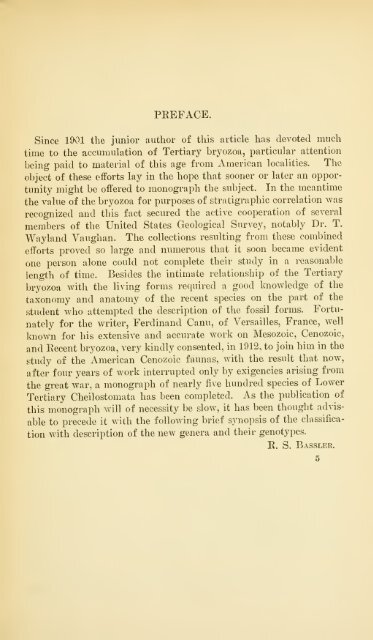Bulletin - United States National Museum - Smithsonian Institution
Bulletin - United States National Museum - Smithsonian Institution
Bulletin - United States National Museum - Smithsonian Institution
Create successful ePaper yourself
Turn your PDF publications into a flip-book with our unique Google optimized e-Paper software.
PREFACE.<br />
Since 19vU the junior author of this article has devoted much<br />
time to the accumulation of Tertiary bryozoa, particular attention<br />
being paid to material of this age from American localities. The<br />
object of these efforts lay in the hope that sooner or later an opportunity<br />
might be offered to monogi-aph the subject. In the meantime<br />
the value of the bryozoa for purposes of stratigraphic correlation was<br />
recognized and this fact secured the active cooperation of several<br />
members of the <strong>United</strong> <strong>States</strong> Geological Survey, notably Dr. T.<br />
Wayland Vaughan. The collections resulting from these combined<br />
efforts proved so large and numerous that it soon became evident<br />
one person alone could not complete their study in a reasonable<br />
length of time. Besides the intimate relationship of the Tertiary<br />
bryozoa with the living forms required a good Imowledge of the<br />
taxonomy and anatomy of the recent species on the part of the<br />
student who attempted the description of the fossil forms. Fortu-<br />
nately for the writer, Ferdinand Canu, of Versailles, France, well<br />
known for his extensive and accurate work on Mesozoic, Cenozoic,<br />
and Recent bryozoa, very kindly consented, in 1912, to join him in the<br />
study of the American Cenozoic faunas, with the result that now,<br />
after four years of work interrupted only by exigencies arising from<br />
the great war, a monograph of nearly five hundred species of Lower<br />
Tertiary Cheilostomata has been completed. As the publication of<br />
this monograph will of necessity be slow, it has been thought advis-<br />
able to precede it with the following brief synopsis of the classifica-<br />
tion with description of the new genera and their genotypes.<br />
R. S. Bassler.<br />
5

















